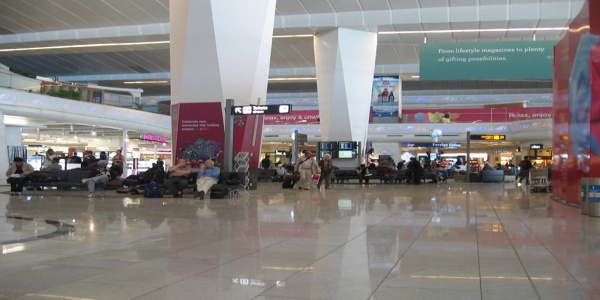A couple posts earlier, in the one which explains, how to arrive in Delhi, I had mentioned and in fact made it explicitly clear that if you’d like to arrive in style and have a super duper comfy journey, commuting by air is the best option. I felt it appropriate to elaborate more on the Delhi Airport and highlight the details of the facilities which this world class airport has to offer to its commuters. Read on for a detailed bio of the New Delhi Airport.
The New Delhi Airport is better known as The Indira Gandhi International Airport or simply IGI Airport. Though the name mentions International, there’s nothing to worry about since the airport also, obviously, has a domestic terminal ;-). As a matter of fact, both the International and domestic terminals are perfectly integrated from within, however from the outside, it might look like the domestic terminal is about 7 to 8 km away from the International one.

IGI Airport is the primary international airport of saddi Dilli and the NCR of, in South-West Dilli, about 16 km southwest of the Delhi’s city center. The Delhi Airport is named after Indira Gandhi, the former Prime Minister of India, and it is the busiest airport in India today. With the start of operations at the new Terminal 3 (T3), Delhi’s IGI Airport has become India’s and South Asia’s largest and one of the most important aviation hub, with a current capacity of handling more than 46 million passengers and for handling more than 100 million passengers by 2030. Together with Mumbai’s Chhatrapati Shivaji International Airport, it handles more than half of the air traffic in South Asia. The airport’s operator, Delhi International Airport Private Limited or DIAL, is looking to make the airport the next international transit hub.

The Delhi Airport spreads over an area of 5,220 acres of land and serves as the primary civil aviation hub for the National Capital Region of India. It was previously operated by the Indian Air Force until its management was transferred to the Airport Authority of India (AAI). In May 2006, the management of the airport was passed over to DIAL which is a joint venture led by the GMR Group, which also has the responsibility for the airport’s ongoing expansion and modernization.
Some salient but important features of the Delhi Airport are:
- A 9 level passenger terminal building having 2 piers each 1.2 km long
- An in-line Baggage Handling System with capacity to handle 12,800 bags per hour
- 6 Common check-in islands with 168 check-in counters
- 95 Immigration counters (49 Outbound and 46 Inbound Immigration counters)
- 78 Passenger Boarding Bridges (including 3 Passenger Boarding Bridges for A380 or similar sized aircraft)
- 14 Baggage reclaim belts including 2 belts for Out of Gauge (OOG) bags
- 6.7 million sq ft. of apron area
- 100 room Transit Hotel for Domestic and International passengers (68 rooms for domestic transit and 32 rooms for international transit)
- 96 automatic travelators / walkways (Longest one being 118 mts in length)
- Over 20,000 sq mters. of retail space
- Multi-level car park to accommodate 4300 cars
- 7 MLD Water and 10 MLD Sewage Treatment Plant (total quantity for entire airport, treatment plant inside airport premises only)
- World class duty free and shopping avenues
- Houses all prominent food brands serving vegetarian, non-vegetarian and continental food

The Delhi Airport is well connected to the city through all the modes of transport. The connectivity now however has attained the next level since the time the Delhi Metro has added both the terminals on its map. From any of the terminals, the Delhi Metro is easily accessible and it makes the approach to the city absolutely hassle free.




Leave a Reply